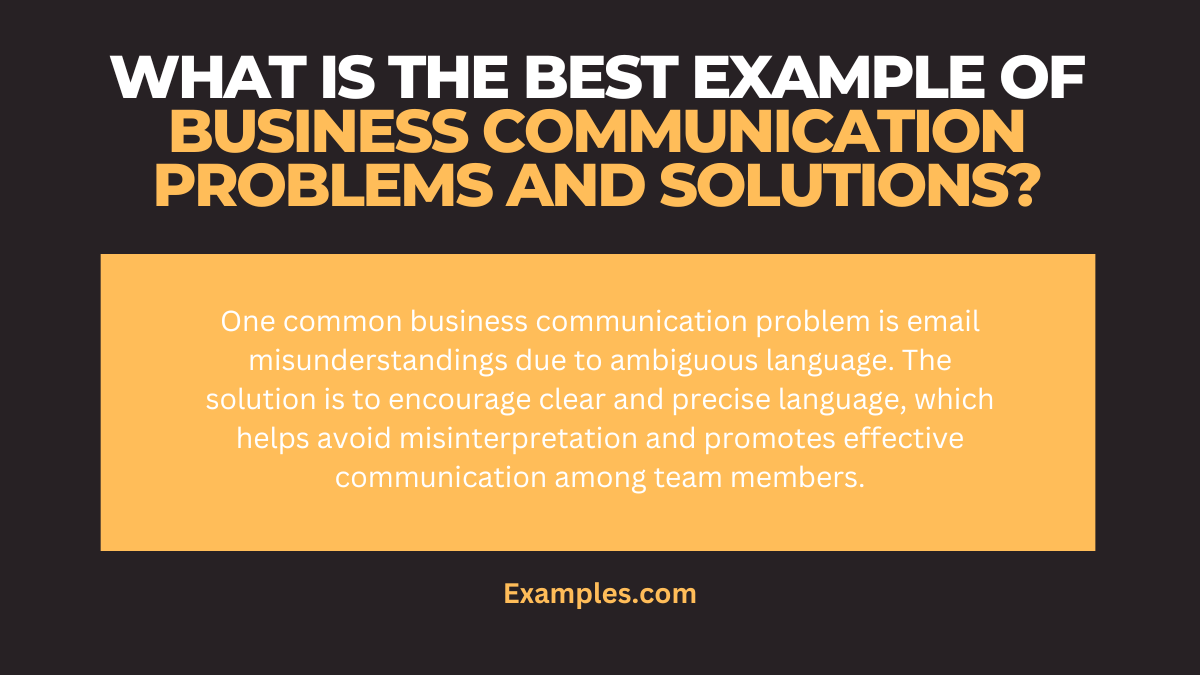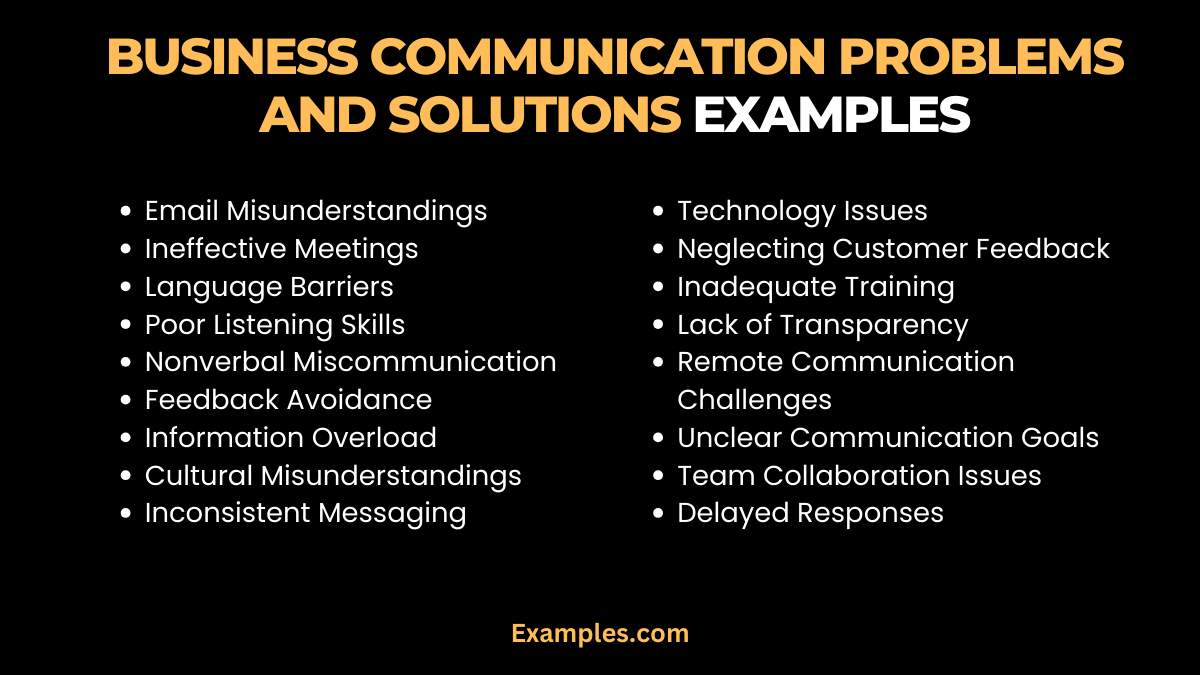19+ Business Communication Problems and Solutions Examples
Navigating the complexities of business communication requires understanding both the challenges and the solutions. This guide delves into common communication issues in the workplace, offering communication examples and practical solutions. From resolving team communication barriers to enhancing interdepartmental communication, it addresses various scenarios such as workplace miscommunication issues and provides strategies for effective communication in business. Whether it’s through digital communication tools or improving employee communication skills, this guide is an essential resource for tackling communication hurdles in any business setting.
Download Communication Solutions for Common Problems in Business PDF
What is the best Example of Business Communication Problems and Solutions?

A classic example of business communication problems and solutions is seen in email miscommunication within a company. Often, emails can be misinterpreted due to lack of tone or clarity. The solution lies in implementing clear guidelines for email communication, such as using specific subject lines, concise language, and including clear calls to action. Additionally, fostering a culture of open feedback and follow-up meetings can ensure that the message is understood as intended, thereby reducing the likelihood of miscommunication.
20 Business Communication Problems and Solutions Examples:

In the world of business, communication plays a pivotal role in ensuring smooth operations and successful interactions. Yet, it often encounters various hurdles that can disrupt the flow of information and collaboration. Addressing these challenges requires both identification of the problems and implementing effective solutions.
- Email Misunderstandings:
- Cause: Ambiguous language.
- Solution: Encourage clear and precise language.
- Ineffective Meetings:
- Cause: Lack of agenda.
- Solution: Always prepare a meeting agenda.
- Language Barriers:
- Cause: Multilingual workplace.
- Solution: Provide language support or translation services.
- Poor Listening Skills:
- Cause: Inattention.
- Solution: Train employees in active listening.
- Overreliance on Digital Communication:
- Cause: Technology preference.
- Solution: Balance with face-to-face interactions.
- Nonverbal Miscommunication:
- Cause: Body language misinterpretation.
- Solution: Educate on nonverbal cues.
- Feedback Avoidance:
- Cause: Fear of conflict.
- Solution: Create a safe feedback culture.
- Information Overload:
- Cause: Excessive data.
- Solution: Streamline communication channels.
- Cultural Misunderstandings:
- Cause: Diverse workforce.
- Solution: Provide cultural awareness training.
- Inconsistent Messaging:
- Cause: Lack of communication strategy.
- Solution: Develop a unified messaging guide.
- Technology Issues:
- Cause: Outdated tools.
- Solution: Invest in modern communication technology.
- Conflicting Communication Styles:
- Cause: Personal differences.
- Solution: Acknowledge and adapt to different styles.
- Lack of Transparency:
- Cause: Withholding information.
- Solution: Promote openness and honesty.
- Remote Communication Challenges:
- Cause: Geographical distance.
- Solution: Utilize video conferencing tools.
- Unclear Communication Goals:
- Cause: Vague objectives.
- Solution: Set clear, specific communication objectives.
- Team Collaboration Issues:
- Cause: Lack of teamwork.
- Solution: Foster a collaborative environment.
- Delayed Responses:
- Cause: Time management problems.
- Solution: Set expectations for response times.
- Gossip and Rumors:
- Cause: Informal networks.
- Solution: Address misinformation promptly
- Neglecting Customer Feedback:
- Cause: Inadequate customer focus.
- Solution: Regularly solicit and act on customer feedback.
- Inadequate Training:
- Cause: Skill gaps.
- Solution: Offer communication skills training programs.
Business Communication Problems and Solutions in the Workplace:
In the workplace, effective communication is essential for smooth operations. However, various issues can arise, disrupting this flow. Identifying these problems and implementing practical solutions is key to maintaining a productive work environment. From overcoming miscommunication to adapting to diverse communication styles, the solutions lie in strategic approaches tailored to specific workplace scenarios.
- Vague Instructions: Leads to confusion and errors.
- “Please provide detailed steps for the task to ensure clarity.”
- Infrequent Updates: Causes information gaps.
- “We will have brief weekly updates to keep everyone informed.”
- Overwhelming Emails: Leads to information overload.
- “Let’s limit emails to essential communication and summarize key points.”
- Ignoring Employee Input: Decreases morale.
- “Your suggestions are valuable; let’s discuss them in our meeting.”
- Inconsistent Information: Causes distrust.
- “We will ensure all departments receive the same updates simultaneously.”
- Excessive Jargon: Hinders understanding.
- “Let’s use clear and simple language for better comprehension.”
- Lack of Feedback Channels: Reduces improvement opportunities.
- “We have introduced a feedback form for your suggestions.”
- Poor Meeting Management: Wastes time.
- “Our meetings will now have a set agenda and time limit.”
- Cultural Miscommunication: Leads to conflicts.
- “We provide cultural sensitivity training to enhance mutual understanding.”
- Technology Misuse: Decreases efficiency.”Let’s use our communication platforms more effectively for team collaboration.
Common Communication Problems and Solutions:
Common communication problems in various environments, like workplaces, can significantly impact productivity and relationships. Solutions to these problems involve strategic approaches that enhance clarity, understanding, and engagement. From tackling misinterpretations to improving digital communication effectiveness, the key lies in identifying specific issues and applying targeted solutions.
- Misinterpretation of Messages:
- Misunderstandings due to unclear messaging.
- “To avoid confusion, let’s clarify the main points in our communications.”
- Lack of Active Listening:
- Not fully engaging with the speaker.
- “Let’s practice active listening in our conversations to ensure we understand each other.”
- Ineffective Written Communication:
- Poorly structured emails or documents.
- “Use bullet points and clear headings in emails for better readability.”
- Communication Overload:
- Too much information at once.
- “We will limit our meetings to focus on key topics only.”
- Avoiding Difficult Conversations:
- Skipping crucial but challenging discussions.
- “It’s important we address all issues openly, even the challenging ones.”
- Non-Verbal Miscommunication:
- Body language contradicting verbal messages.
- “Ensure your body language aligns with what you’re saying.”
- Technological Barriers:
- Issues with digital communication tools.
- “Let’s ensure everyone is trained on how to use our communication platforms effectively.”
- Cultural Differences:
- Misunderstandings arising from cultural diversity.
- “We encourage learning about different cultures to improve our team communication.”
- Feedback Loop Absence:
- Not having a system for feedback.
- “Regular feedback helps us improve, let’s make it a routine practice.”
- Assuming Rather Than Asking:
- Making assumptions in communication.
- “When in doubt, it’s always better to ask for clarification
How Can You Solve Business Communication Challenges?
Solving business communication challenges involves several key strategies:
- Identify Communication Issues: Recognize specific areas where communication breakdowns occur.
- Encourage Open Dialogue: Create an environment where employees feel safe to express their ideas and concerns.
- Implement Feedback Systems: Establish regular feedback channels to gather insights and make improvements.
- Train Staff in Communication Skills: Offer training programs to enhance employees’ communication abilities.
- Leverage Technology: Use digital tools to facilitate better communication across the organization.
- Promote Active Listening: Encourage team members to listen actively and empathetically to others.
- Clarify and Simplify Messages: Ensure all communication is clear and to the point to avoid misunderstandings.
- Address Cultural Differences: Be aware of and sensitive to cultural variations in communication styles.
- Monitor and Adapt Strategies: Regularly assess the effectiveness of communication strategies and adjust as needed.
- Lead by Example: Management should model effective communication behaviors.
How to Fix Business Communication Problems?

Fixing business communication problems involves several strategic steps:
- Identify the Issues: Recognize specific communication challenges within the organization.
- Encourage Open Dialogue: Foster an environment where employees feel comfortable sharing their thoughts and concerns.
- Implement Training Programs: Offer training to improve communication skills like active listening and clear writing.
- Utilize Effective Tools: Adopt digital communication tools that suit your team’s needs.
- Set Clear Communication Policies: Establish guidelines for how communication should occur within the business.
- Promote Feedback Culture: Regularly gather and act on feedback from employees.
- Monitor and Adjust Strategies: Continuously assess the effective of communication strategies and make necessary adjustments.
- Address Cultural Barriers: Be aware of and sensitive to cultural differences in communication.
How to Solve Business Communication Problems in a Team?
To solve business communication problems in a team, encourage open dialogue, provide training for effective communication skills, utilize appropriate digital tools, establish clear communication policies, and create a feedback-friendly environment. Regular monitoring and adapting communication strategies based on team needs are also crucial.
The article on Examples.com provides a thorough insight into “Business Communication Problems and Solutions.” It highlights various communication issues commonly faced in the workplace and offers practical solutions to these problems. The guide covers topics such as email misunderstandings, ineffective meetings, language barriers, and more, presenting strategies like clear language use, setting meeting agendas, and language support services.
For a detailed conclusion and more comprehensive strategies, consider exploring additional resources that can offer further insights ways to overcome communication problems in the workplace,provides insights on overcoming bad workplace communication.



